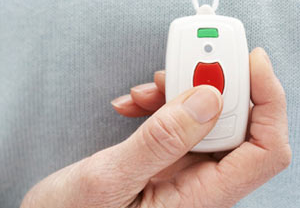
Staying Independent – Personal Alarms
What are personal alarms?
Personal alarms help to provide peace of mind for you and your carer whilst supporting independent living. They differ from Telecare systems because they do not alert a response centre, but instead directly alert a carer in the home or nearby or neighbour. Some need operating by the person being cared for, such as a portable alarm, and some are operated using sensors, such as a movement alarm or a wandering alarm.
What types of alarms can I choose from?
Portable Alarms – these are often worn on the wrist or attached to the clothing of the person being cared for. They emit a high pitched alarm when activated which can be heard from a limited distance.
Portable alarms with a fixed position receiver – As with portable alarms, these are worn by the individual, but when activated, the sound of the alarm comes from a fixed receiver on the wall or other fixed position where a carer will be able to hear.
Portable alarm and Portable Receiver – the alarm is worn by the individual being care for and the receiver is worn by the carer, so they will be alerted by the alarm but are able to move a little more freely (ie the carer can move from room to rrom, and can be out of earshot of the person they are looking after). The range is limited and is suitable for use in the home or garden.
Fixed position alarm – these have a fixed transmitter and receiver and are operated by a button in a fixed position or a pull cord. This sends a high pitched alarm which can be heard by anyone within a limited distance.
I am not confident about pressing an alarm – what are my other options?
Intercoms – A portable system, similar to a baby monitor which can work either by transmitting speech one way or both ways, allowing a carer to be elsewhere in the house.
Fall alarms – an alarm which will be automatically activated if the person wearing it falls and lies without moving for a set amount of seconds. A signal will be sent to a pager held by the carer, or an an autodial alarm telephone is activated.
Movement monitors - these are often placed beneath mattresses and can set off an alarm if seizures are detected or vital signs are not registering.
Wandering alarms – often used for people with dementia, these alarms are activated by pressure sensors located in a doorway. They will alert the carer if the person gets out of bed or leaves the house.
Hypothermia alarms - his is used to monitor the ambient temperature. The alarm is triggered if the temperature falls below a designated level.
If you feel that a personal alarm is suitable for you or the person you are caring for, you may be able to ask social services to provide one as part of your care package. Contact your care manager or local social services for more information.
Written for yourcarehome - author: Mark Sadler
Related Advice Articles - Staying Independent
Staying Independent - Care in my Own Home
Many of us want to live independently in our own home for as long as possible, but may be in a position where we need a ... More
4 April 2013
Staying Independent - Adaptations to Your Home
If you have chosen to live in your own home, there are many types of specialist equipment or adaptations to your home that can be made ... More
4 April 2013
Staying Independent – Telecare and Telehealth
Telecare and Telehealth are both technology-based system which can help you to live independently by alerting a response centre or a carer if there is a ... More
4 April 2013
Staying Independent – Occupational Therapy
How can an Occupational Therapist help? If you have decided that you need a little extra help with day to day living but want to remain in ... More
4 April 2013